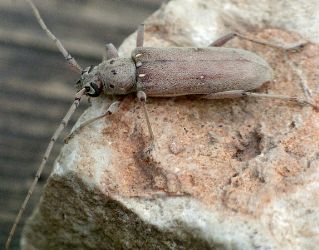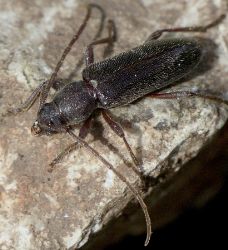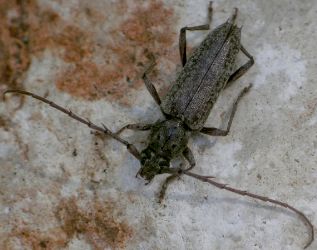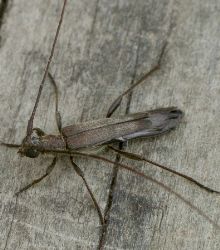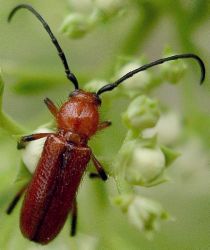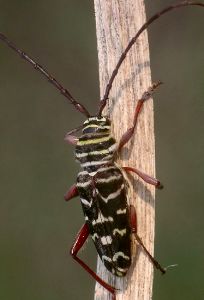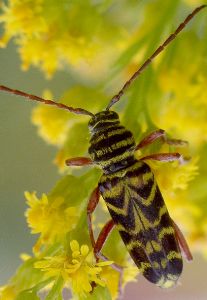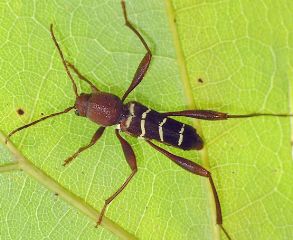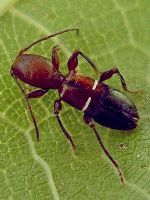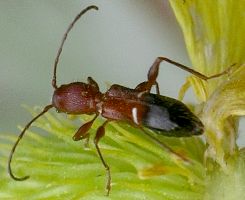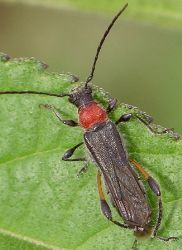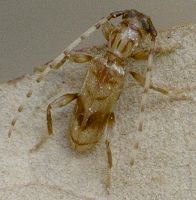
| Cerambycidae ~ Longhorn Beetles |
|
The members of this family are named for their long antennae, sometimes exceedingly so. The antennae of males are usually longer than those of females, and often the antennae are attached to the head in a strange notch at the front of the eye. Sometimes the notch is so deep that it splits the eye in half! In other cases, the antennae are just very close to normal shaped eyes.
Longhorn beetle larvae are called round-headed borers and most feed on dead and decaying wood. Some species feed on living plants. They tunnel inside the wood and so are rarely seen, only emerging as adults. Most species have a limited flight time during which they may be found. Adult longhorn beetles feed on flower nectar, sap, or leaves and bark. They tend to be strong flyers and are sometimes attracted to lights at night. While individuals of some species are almost always the same size, at times there can be rather pronounced variation, both within the same gender and also between males and females. Males can be much smaller than females. Beyond these generalizations, there is great diversity in this family. The size ranges from quite tiny to very large, and there are a variety of body shapes. I've never found any particular species in great numbers; usually they are solitary, mating pairs, or at most a few gathered around a good feeding or breeding spot. For general identification purposes, it helps to divide this family into its well-delineated subfamilies. These groupings are so useful that they are given common names. Many species in our area are in the round-necked longhorn subfamily (Cerambycinae). Although quite diverse, these beetles all have protruding jaws, rather than having them tucked underneath the head. When viewed from above, it is often possible to see the jaws clearly at the front point of the face. Several longhorns are similar in shape and color: sort of long and brown. One that I've seen several times right around our house is Eburia mutica. This is a medium sized beetle, about 15 mm long, and is a velvety texture with small white spots on the elytra (wing covers). The spots are a bit variable, especially those in the center of the body. Although individuals in our area seem to always have very small dots, I've seen images of this species where the same marks are larger and even doubled so that each dot is instead a pair of oval spots. The color of E. mutica is reddish brown, with a dusting of gray. The antennae are really long and there are small rounded black bumps on the pronotum.
About the same size or a bit smaller than the previous species, Anelaphus moestus is a very dark brown color with no markings. The antennae are not quite so long either. The best distinguishing feature is the covering of hair, especially on the eleytra. This is a beetle that has ended up in our house a couple of times, no doubt attracted by the lights. At first glance it resembles a nondescript click beetle but there are plenty of obvious differences between the two families. Another beetle in the same size range, also brown, is Elaphidion linsleyi. Distinguishing characteristics on this one include spikes, on the antennal segments as well as at the rear end of the elytra, and a blotchy look caused by the grayish coating that covers an otherwise sort of shiny and dimpled body.
One slender brown beetle that has some very distinctive features is Styloxus fulleri. This is a smaller species, at about 12-13 mm in length. The elytra do not completely cover the other pair of wings, but end about two thirds down the length of the body. The antennae are super long, with very long thin segments. They eyes are huge on a rather small head. I've only seen this species during November.
The Hickory Borer (Knulliana cincta), is an impressive beetle, reaching up to about 30 mm in length, although some individuals are smaller. The color is brown, with a pair of diagonal tan spots on the elytra, which are sometimes not all that clearly seen. The body is covered with grayish hair and there are spines sticking out of the rear of the elytra. There are also small spines on the sides of the pronotum. The legs are rather long and very slender. Although there are longhorn beetles that are specifically called flower longhorns, there are also some round-necked borers that are likely to be found feeding on nectar. One that I've seen very occasionally is Batyle suturalis. This is a small (about 10-12 mm long) rust colored species with varying amounts of black on the body. The antennae are not terribly long and are black. The texture is shiny with many small dimples in the elytra, and the whole beetle is covered with sparse long hairs.
Longhorn beetles that feed at flowers often resemble wasps, both in movement and coloration. While the previous species matches the color of a paper wasp (Polistes carolina), a Callidium species I've seen is metallic blue-black, similar to several species of sphecid wasps. This small longhorn has beaded-looking antennae and thick femurs. The pronotum is rather flattened and wide. A fairly common longhorn that shows up on flowers in the spring is Placosternus difficilis. This beetle is obviously a wasp mimic, with its yellow stripes on a black body. The legs and antennae are reddish. It is medium sized at about 15 mm in length.
During a very dry autumn, I saw several longhorns flying about that looked quite similar to the previous species. However, there were differences in pattern, and the fact that they were out of season, which caused me to look them up. The Painted Hickory Borer (Megacyllene caryae) looks amazingly like Placosternus difficilis. However, it has mostly white markings that differ slightly, as shown in the photos, with just a touch of yellow.
At the same time, there were a few more robust and definitely more yellow longhorns flying about as well. Although I could never get a photo of one, I suspect they were the Locust Borer (Megacyllene robiniae). I took the accompanying photo in Denver, as this is a very widespread and common species. Even if I am mistaken in thinking that M. robiniae occurs here (I usually only trust a good photo or close-up examination for identifications), it is helpful to see the three look-alikes side by side. One excellent wasp mimic that I've not seen at flowers but have seen mating around its larval host, dead ash branches, is the Red-headed Ash Borer (Neoclytus acuminatus). These small (about 11-12 mm long), slender reddish beetles move about with the same jerky motions as wasps, and fly readily. Their antennae are not particularly long but their legs are.
Wasps are not the only hymenopterans that longhorn beetles can mimic; ants are another model. Species in the genus Euderces are convincing mimics of the acrobat ants (genus Crematogaster). Our most common species is also the smallest. At under 4 mm in length, Euderces reichei really does resemble an ant as it feeds at flowers in the spring. A second species, Euderces picipes is similar but a bit larger (a whopping 5 mm long) and the white band near the center is angled more. This species seems less common and is slightly more elongate in shape than E. reichei. When dealing with insects this small, a single millimeter difference in size is actually quite easy to notice.
Longhorn beetles not only mimic wasps and ants, but also fireflies, which have toxic chemicals in their bodies and very recognizable warning colors: red/orange head and black body. Quite a number of other insects display this simple and effective color pattern, which probably works as long as the mimic is about the same size as a firefly. Stenosphenus dolosus is a rather infrequently seen longhorn. The body is very shiny, with the pronotum exceedingly so. The reddish front and dark rear probably give some protection to this conspicuous diurnal beetle.
Callimoxys sanguinicollis is a very interesting looking firefly mimic, with a dull and dimpled general appearance. The pronotum is orange and the rest of the body is black, except for the rear legs, which have yellow femurs that end in a black swollen part. The elytra are reduced, only reaching two thirds down the abdomen. The lower half of each wing cover is narrow and they do not connect in the center when folded. One more flower-feeding longhorn that has the firefly colors is a Rhopalophora species. This slender beetle is about 8 mm long, has very thin antennae and legs with obvious swellings. It appears for a brief time in the spring and can be rather numerous on clustered flowers. The longhorn with the shortest elytra I've seen is Molorchus bimaculatus. It is under 7 mm in length and the elytra only cover less than the front half of the abdomen. When a tiny insect like this is crawling about flowers, covered with pollen and showing obvious wings, it is hard at first glance to tell if it is a beetle or wasp.
Another very tiny longhorn is Obrium maculatum. The cryptic brown and tan markings of this beetle help it blend right in with leaves or plant debris. It is rather translucent and its 5 mm length makes it pretty difficult to see. |
![]()
